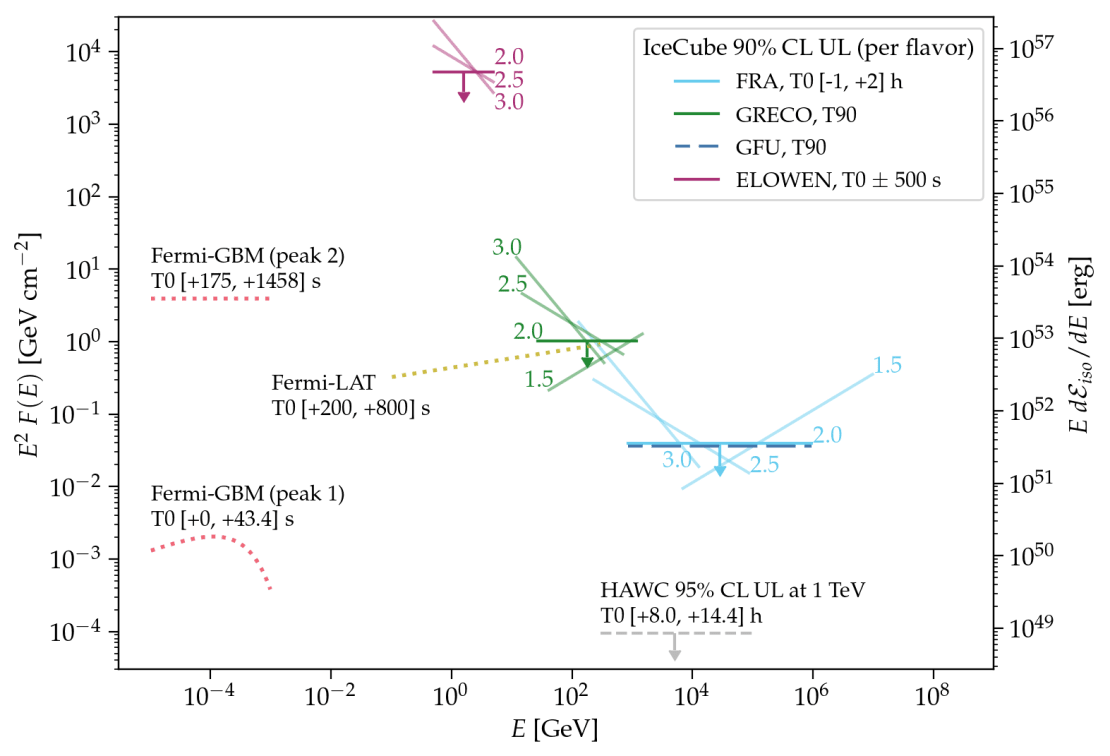On October 9th, 2022, an unusually bright pulse of high-energy radiation whizzed past Earth, captivating astronomers around the world. The luminous emission came from a gamma-ray burst (GRB), one of the most powerful classes of explosions in the universe. Named GRB 221009A, it triggered detectors at NASA’s Gamma-ray Burst Monitor and Large Area Telescope (both on board the Fermi Gamma-ray Space Telescope), the Neil Gehrels Swift Observatory, and the Wind spacecraft and other telescopes that quickly turned to the GRB site to study its aftermath. It became the first GRB detected by a ground-based gamma-ray detector above 10 teraelectronvolts.
This record-shattering GRB is one of the closest and the brightest GRB ever spotted, earning it the nickname BOAT (“brightest of all time”). This GRB is believed to have come from an exploding star and likely signals the birth of a black hole.
In a new study published today in The Astrophysical Journal Letters, the IceCube Collaboration presents the results of five searches for neutrino emission from GRB 221009A that leveraged the full detector range, covering nine orders of magnitude in energy. Because no significant emission was found across samples spanning 10 MeV to 10 PeV, the results are the most stringent constraints on neutrino emission from GRBs.
As some of the most energetic sources in the universe, GRBs have long been considered a possible astrophysical source of neutrinos—tiny “ghostlike” particles that travel through space and large amounts of matter unhindered. These high-energy neutrinos are of particular interest to the IceCube Neutrino Observatory, a gigaton-scale neutrino detector at the South Pole.
Previously, IceCube has performed searches for neutrino emission from GRBs, but thus far, a correlation has not been found between high-energy neutrinos and GRBs. The recent observation of GRB 221009A presented IceCube with the best opportunity yet to search for neutrino emission.

The five complementary IceCube analyses encompassed the full energy range of the detector and were carried out by main analyzers Bennett Brinson, Karlijn Kruiswijk, Rachel Procter-Murphy, Jessie Thwaites, and Nora Valtonen-Mattila.
“This was a coordinated effort across multiple analyses, each targeting a specific energy range,” says Brinson, a physics PhD student at the Georgia Institute of Technology. “Different models for neutrino emission from GRBs predict emission in different energy ranges, so the idea was to cover as wide an energy range as possible.”
Brinson’s analysis was based on the GeV Reconstructed Events with Containment for Oscillations (GRECO) sample, which focuses on the low-to-medium energy (10-1000 gigaelectronvolts) neutrino events. He looked for neutrinos from the direction of GRB 221009A using longer time windows before and after the GRB.
At even lower energies, Valtonen-Mattila searched for megaelectronvolt neutrino emission, based on predictions of thermal neutrinos originating from supernovae or star explosions.
“Since we are dealing with very low energy neutrinos, we made use of the supernova data acquisition to look for possible megaelectronvolt neutrino emission,” says Valtonen-Mattila, a physics PhD student at Uppsala University in Sweden.
Thwaites, a physics PhD student at the University of Wisconsin–Madison, performed a “fast response” analysis based on real-time data from the South Pole to search for high-energy (0.10 teraelectronvolts to 10 petaelectronvolts) neutrinos from the direction of the GRB. Their analysis, which set strong constraints on neutrino emission from GRBs, was quickly reported to the community, within hours of the GRB being detected by the gamma-ray satellites.
A similar analysis done by Procter-Murphy, a physics PhD student at the University of Maryland, added three additional time windows, although not in real time. Even though neutrino emission was not found, Procter-Murphy is currently developing a tool that will automatically search ten time windows when a new GRB is detected. “This tool will send an internal alert to IceCube if it detects anything significant, allowing IceCube to quickly respond to any significant detections,” says Procter-Murphy.
The last analysis, conducted by Kruiswijk, used the Extremely Low-Energy (ELOWEN) event sample to search for low-energy neutrino emission during solar flares, in the range of 0.5-5 gigaelectronvolts. Kruiswijk is a physics PhD student at UCLouvain in Belgium.
“We did not observe any neutrinos from GRB 221009A, however, that does not mean we did not learn anything,” says Kruiswijk. “With upper limits, combined with those from other searches, we can look at what processes are and are not possible in GRBs by how much neutrino flux they emit.”
Because this GRB is so bright, and because it has been so well studied, IceCube is able to place constraining upper limits on neutrino emission models proposed for this specific GRB. These constraints will enable better understanding of how GRBs work.
The collaborators are already developing new methods to improve searches for neutrinos from GRBs and other transient astrophysical sources. In addition, future upgrades and proposed extensions of IceCube, including the IceCube Upgrade project and IceCube-Gen2, could be the key to finding high-energy neutrino emission from GRBs or other transients.
Thwaites concludes, “In the high energies, our upper limits are very constraining—they are below the observations from gamma-ray telescopes. These upper limits, combined with the observations from many electromagnetic telescopes, give us more information about GRBs as potential particle accelerators.”
+ info “Limits on Neutrino Emission from GRB 221009A from MeV to PeV using the IceCube Neutrino Observatory,” IceCube Collaboration: R. Abbasi et al., ApJL 946 L26 (2023), https://iopscience.iop.org, arxiv.org/abs/2302.05459